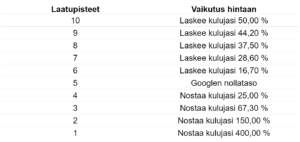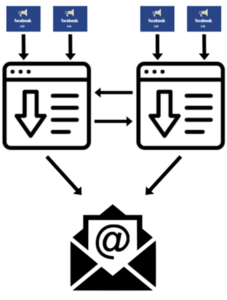Why does the content on your website determine the results of your marketing?
Your account’s journey towards purchase always starts with an ad or a search result, from where it logically continues to the landing page on your website. The amount of content on your website directly affects the number of topics that are discussed in ads. In other words, the amount of content on your website either allows, or restricts the making of various ads.
Your customer moves from one content to another on your website, maybe exits and returns there, for example, through your Facebook remarketing.
The amount of content on your website also directly affects all other marketing efforts. Every time new quality content is created for your website, it starts to bring free traffic from search engines. The content also enables you to create new social media ads and more cost-effective search engine advertising (Google Ads). So we can sum it up as follows: The more quality content your website has, the better results you will get from all your marketing efforts.
In order to ensure that your customer is ready to contact you, they must learn from the content of your website things that bother them or are unclear. When your customer has been confident that they will be able to carry out the acquisition and that your company is the right partner for them, they will contact you.
As the amount of content consumed, i.e. the number of pages viewed, increases, so does the conversion rate of your web pages. That is, a higher percentage of those who come to your website to contact you and your sales will increase.
It is often mistaken to think when you start advertising that advertising itself increases sales. Euros are invested in advertising, the advertiser is paid for the work and paid to Facebook or Google, for example, for the ads themselves. The costs of marketing a company increases immediately when advertising is started and expectations regarding the results are naturally relative to the euros invested.
If the results are not as good as expected, the finger of blame often points to advertising. In most cases, however, the bottleneck in the results is the company’s website and, above all, the lack of high-quality content, rather than advertising.
You should remember that the main goal of your advertising is to capture the interest from the ad viewer and get them to click on your ad on your website. The content of your website is to make your potential customer understand that your service or product is useful to them and should buy it. With ads alone, you cannot get this done.
Digital marketing can be simplified in the following formula.
Number of visitors to your website x conversion rate of your website = number of contacts (or sales).
You can influence both aspects, the number of visitors, and the conversion rate of your website by the quantity and quality of the content on your website.
We can influence the number of visitors, for example, with search engine optimization (needs content for your website), Google with search terms, Google Display advertising, YouTube advertising, social media advertising, etc.
The conversion rate of your website can be influenced by high-quality content that provides your potential customers with interesting and useful information about your service or product and guides your customer through the purchase process.
Next, let’s go one channel at a time to see how the content on your website affects how well you get results from different channels.
Reading tip: Content marketing is the most important element of your entire digital marketing
How does the content on your website affect the amount of free traffic and business benefits from search engines?
Google’s goal is to provide Google users with the most relevant and high-quality content possible as quickly as possible. What does this mean in practice? When your potential customer writes a question in Google’s search engine, for example, what does Google do? Google provides links to the websites where it believes it can find the best answer to the question asked by the applicant.
The question for you is, do you want your potential customer to find a good answer to their question on your website or on the website from your worst competitor?
With the help of keyword research, we find out what your customers are looking for on Google. With this information, we create a content plan that responds to your customers’ searches. This will get customers interested in your services and products to your website and give them a good customer experience by providing them with the exact information that they are looking for.
The more search engine-optimized content you produce, the more often you get your potential customers to visit your website. The more you provide your potential customers with information that interests them, the more they trust you and buy from you.
How does the content of your website affect the costs and business benefits of search engine advertising?
When your customers search for searches related to your business using Google’s search engine, they will see the first paid Google AdWords ads at the top of the results page. AdWords ads look very similar to Google’s organic (free) results.
One of the most important factors influencing the cost of your Google AdWords advertising is your ads quality score. Ad quality scores are influenced by 3 main factors: The expected clickthrough rate of the ad, how relevant the ad text is to the search term and the quality of the landing page. The landing page experience your potential customer gets after clicking on your ad affects the price you pay for the click and where your ad appears.
In the worst-case scenario, if your landing page experience is really poor, it could even happen that your ad does not appear at all. Google AdWords has quality scores ranging from 1 to 10. If your quality score is less than 5, Google will start charging you an extra price for each click. Your advertising will be more expensive, and your competitiveness will be reduced.

However, quality scores and click prices are not the main factors affected by the landing page experience. You are doing your marketing for your customers, not Google. When your customer sees your ad, they assume that based on the text in the ad, they will receive some specific information after clicking on the ad. The story always starts with an ad from which it logically continues on the landing page of your website.
For Google AdWords, the same principle applies as for SEO. The more SEO content you produce on your website, the more relevant landing pages you have related to your customers’ searches. Again, the same question can be asked here, do you want your potential customer to find the answer to their searches on the website of your worst competitor or your company?
How does the content on your website affect the effectiveness and business benefits of Display, video, and social media advertising?
Google Display, YouTube, Facebook, Instagram, LinkedIn and other social media channels differ from Google search engine optimization and paid search engine advertising. This distinction is important to understand. People coming from search engines are already looking for information on the topic for which you have answers. Display, YouTube and social media advertising, on the other hand, always interrupts what your potential customer was initially doing. Your potential customer can be browsing cat videos on social media, reading news from the Evening Press, or watching Americas Got Talent on YouTube. In such a context, the ad always comes as a surprise.
In these cases, the amount and quality of content on your website will become even more pronounced. When we pause the cat video viewing, the ad’s message and image (or video) must capture the interest of the person to whom the ad will be shown. The ad must be so interesting that it is more interesting than the cat videos or the social media updates from their friends. It is to be taken into account that this person is not actively seeking information about your company’s services.
When a properly targeted ad gets your potential customer to pay attention to an ad and gets them interested in the topic so much that they click on your website from the ad, the landing page must offer what the ad promised. Unless the story that started in the ad continues on the landing page of your website, your customer feels that they have been misled and will exit by clicking the back button on the browser.
In search engine advertising, your customer may still forgive you if the story that started with the ad’s text does not quite continue on the landing page of your website. For example, if your customer searches for information about the prices of a particular service segment, but your website does not have any content on pricing, so you redirect your customers to the front page of your website. Your potential customer may still forgive you if, for example, they learn here that your company also offers the service they intended to buy. So, the game may not have been lost at this point. Of course, everyone understands that if your customer is looking for information about prices, they should be provided with information about prices.
What if the above example were to happen even in social media advertising? Then the ad interrupts someone who is about to do something completely different and is not actively looking for the services you provide. They will somehow be interested in the ad and its subject, redirecting the person to your website, which does not give the information that the ad implied. What are you betting on? What is this person doing? Yes, they will click on that back button and continue watching cat videos.

The diagram above illustrates how the content on the website both limits and enables the creation of various social media ads. This same principle also applies to YouTube and Display advertising. One page on your website talks about one or a few topics that are very closely related to each other. Making good advertising always starts with a detailed analysis of the individual pages of your website. The result of the analysis is to plan which pages it makes sense to redirect from the ads, and what kind of beginnings the story can have in the ads.
How does high-quality content and its volume directly affect the conversion rate of your website?
You do not make content just for the sake of content. You make content to achieve business benefits, either in the short or long term. Well-designed and implemented content guides your customer through the purchase process. The purchasing process can also be thought of as a learning process. When a potential customer reads one post on your website, they find a link to another post in the text.
We can take a look at the analytics figures for almost any company website and see that the more pages people have read, the more likely they are to have bought, or contacted. This means that the conversion rate of your web pages increases as the number of pages read increases.
If there is only one written blog post on your website, your customers can only read this one blog post. If your website provides 100 well-written articles that provide your customers with useful information about the services you provide, your customers will have the opportunity to read 100 different kind of content. This is not rocket science. It requires a touch of common sense to understand this logic, even if you are not a marketing expert.
How do you find out what kind of content and how much content your website should have?
It has certainly already become clear that content is important and affects the effectiveness and productivity of all marketing channels. Finally, let’s go over how you know what kind of content and how much content you need.
For this we have tested methods in place to achieve results with certainty.
- An analysis of the purchase process of your services (as part of the buyer persona survey) helps to understand what kind of people are influencing the purchase process from the very beginning of the purchase process to the final purchase decision.
- Buyer personality support (included in the purchase process analysis) helps to understand the motives of those involved in the purchasing process, the buying barriers and the need for information at different stages of the purchase process
- Keyword research tells us what kind of search terms your potential customers use to search for information about the services or products you offer.
An properly conducted buyer persona survey and a keyword research give a very good and accurate picture of what kind of content is needed on your website to make your advertising cost-effective and achieve the desired business benefits.


